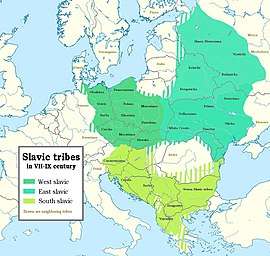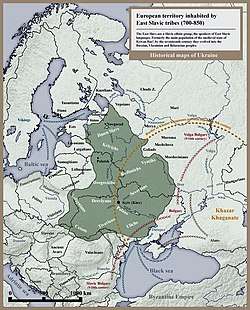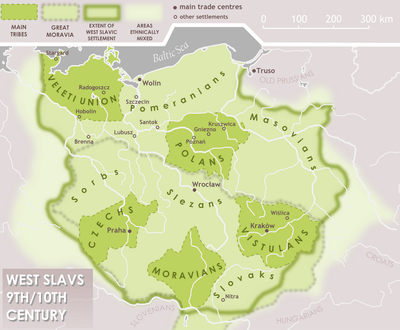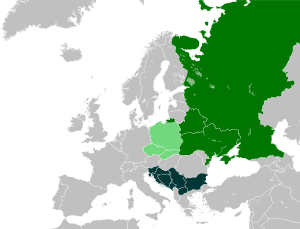List of ancient Slavic peoples and tribes
This is a list of Slavic peoples and Slavic tribes reported in Late Antiquity and in the Middle Ages, that is, before the year AD 1500.




| Part of a series on |
| Indo-European topics |
|---|
 |
|
|
Philology
|
|
Origins |
|
Archaeology Pontic Steppe
Caucasus East Asia Eastern Europe Northern Europe Pontic Steppe Northern/Eastern Steppe Europe
South Asia Steppe Europe Caucasus India |
|
Peoples and societies Indo-Aryans Iranians
East Asia Europe East Asia Europe
Indo-Aryan Iranian
|
|
Religion and mythology
Indo-Aryan Iranian Others Europe
|
|
Late Antiquity
- Veneti / Sporoi (common ancestors of all Slavs and the West Slavs with the same name)
- Antes (ancestors of the East Slavs; some were also the ancestors of part of West Slavs and South Slavs)
- Veneti (ancestors of the West Slavs; some were also the ancestors of part of East Slavs and South Slavs)
- Sclaveni (ancestors of the South Slavs)
Middle Ages
East Slavs

- Antes (common ancestors of the East Slavs; some were also the ancestors of part of West Slavs and South Slavs)
- Western-Northern groups
- Western Russian group / Western Ruthenian group / Western Old East Slavs ("Russians" or "Russian group" in the broad sense means Old East Slavic peoples, the common group from where modern ethnic groups or peoples of the Rusinians, Ukrainians, Belarusans and Russians descend and not only Russians in the narrow sense)
- Southwestern group
- Buzhans (Buzhane), ancestors of Ukrainians, Russians and possibly Bosnians[2][3]
- Dulebes (Dulebi), ancestors of Ukrainians and Belarusians and part of Czechs. Assimilated into several East Slavic tribes: the Volhynians, Drevlians, Polans, Dregoviches, and possibly Buzhans, eventually to become part of the Kievan Rus'.
- Teverians (Tivertsi), ancestors of Ukrainians and part of Moldovans and Romanians
- Volhynians (Volynyane), ancestors of Ukrainians and part of Czechs
- White Croats (Belyye Khorvaty), ancestors of Croats, Rusyns and Ukrainians and also part of Czechs (they were also among West Slavs)
- Southern group
- Polans (eastern) (Polyane), ancestors of Ukrainians
- Ulichians (Ulichi), ancestors of Ukrainians, Moldovans and Romanians
- Central group
- Dregoviches / Dregovichians (Dregovichi), same with Draguvites, ancestors of Belarusians
- Drevlyans (Drevlyane), ancestors of Ukrainians and Belarusians
- Polochans (Polochane), ancestors of Belarusians
- Radimichians / Radimichs (Radimichi), ancestors of Belarusians and part of Russians
- Severians (Severyane), ancestors of Ukrainians, Russians and part of Slavic Bulgarians
- Southwestern group
- Old Russian group / Northern Russian group / Northern Ruthenian group / Northern Old East Slavs
- Northeastern group
- Krivichians (Krivichi), ancestors of Belarusians and Russians
- Vyatichians (Vyatichi) also Oka Slavs, ancestors of Russians[4]
- Northeastern group
- Western Russian group / Western Ruthenian group / Western Old East Slavs ("Russians" or "Russian group" in the broad sense means Old East Slavic peoples, the common group from where modern ethnic groups or peoples of the Rusinians, Ukrainians, Belarusans and Russians descend and not only Russians in the narrow sense)
- Northwestern group (possible Northern Slavic group?)
- Ilmen Slavs / Ilmen Slovenians (Slovene), also known as Novgorod Slovenes, (Slovene) ancestors of Russians
- Western-Northern groups
West Slavs

- Veneti / Wends? (common ancestors of West Slavs; some were also the ancestors of part of South Slavs and East Slavs)
- Czech–Slovak group
- Bohemians / Slavic Bohemians (Chekhove), tribal confederation, in Bohemia, Czech Republic. Ancestors of Czechs
- Berunzani (a Slavic Bohemian tribe, Chekhove, of West Bohemia)
- Bohemians proper (Chekhove proper) also known as Pragani, the tribe that livd in Praga/Praha region, Central Bohemia or Central Czechia.
- Děčané, in Děčín region, Czech Republic
- Dudlebi (Bohemian Dulebes), a group of Dulebes assimilated as a Slavic Bohemian or Czech tribe.
- Gbane / Hbane
- Kharvati / Kharvattsi (Bohemian Croats), a group of White Croats assimilated as a Slavic Bohemian or Czech tribe.
- Litoměřici or Lutomerizi, in the Czech lands from the sixth century (they lived in the Litoměřice region)
- Luchane / Luchani / Lutsane
- Lemuzi
- Lupiglai
- Pshovane
- Sedlichane
- Volynyane, a group of Volhynians assimilated as a Slavic Bohemian or Czech tribe.
- Zlicans (Zlitsans) / Zlichane, in Bohemia (Czech). Ancestors of Czechs and possibly Poles
- Moravians / Northern Merehani (Moravane), tribal confederation, in Záhorie (Slovakia) and Moravia. Ancestors of (modern) Moravians and part of the Slovaks. The Morava river of Moravia was in their lands. Ancestors of the South Moravians (Merehani), in Morava river valley, east Serbia, that migrated south of the Danube and were assimilated by South Slavs.
- Nitran Slavs (or Slovene, Northern Slovene) / Old Slovaks / Vah Slavs, tribal confederation, in Slovakia and Northern Hungary. Ancestors of Slovaks and of part of the Slovenes / Caranthanians.
- Bohemians / Slavic Bohemians (Chekhove), tribal confederation, in Bohemia, Czech Republic. Ancestors of Czechs
- Lechitic group
- Lendians, in east Lesser Poland and Red Ruthenia (Poland and Ukraine). Ancestors of Poles
- Masovians, tribal confederation, in Mazovia, Poland. Ancestors of Poles
- Obotrites / Reragi (Northern Polabians), tribal confederation, in Mecklenburg-Vorpommern, Germany.
- Belesem / Byelozem = "White Earth" or "White Earth Tribe", they lived scattered in Oster Walde / Osterwalde - "Eastern Woods" in the Old Mainland Saxon view, west banks of the Elbe river
- Drevani = "Wood" or "Wood Tribe", they lived scattered in Oster Walde / Osterwalde - "Eastern Woods" in the Old Mainland Saxon view, west banks of the Elbe river) (Osterwalde and Luneburg Heath also matched the land where the Langobards lived for a time before migrating towards South) (mostly in today's Lower Saxony, in the Hanoverian Wendland, Germany)
- Linonen, near Lenzen.
- Lipani, tribe that lived scattered in the west banks of Elbe river
- Obotrites proper / Northern Obotrites (Wismar Bay to Lake Schwerin).
- Polabians proper, in eastern Schleswig-Holstein, Germany.
- Travnjane east of the Trave.
- Wagri / Wagrians (the eastern Holstein as part of Saxony).
- Warnabi / Warnower, in Mecklenburg (Germany), (the upper Warnow and Mildenitz).
- Polans (western), tribal confederation, in Greater Poland, Poland. Ancestors of Poles.
- Pomeranians, tribal confederation, in Pomerania, Germany and Poland. Ancestors of Poles, Kashubians, and Slovincians
- Goplans, in Kuyavian-Pomeranian, Poland. Ancestors of Poles
- Kashubians, in Pomeranian Voivodeship, Poland
- Prissani / Pyritzans (Pyrzyczanie), in Pomerania, Poland. Ancestors of Poles
- Slovincians, a West Slavic tribe that lived between lakes Gardno and Łebsko near Słupsk in Pomerania.
- Wolinians, on Wolin island, Pomerania, Poland. Ancestors of Poles
- Silesians / Silezane / Slezane, Silesia, tribal confederation, Poland. Ancestors of Poles and Silesian Germans
- Veleti (Wilzi) (Northern Polabians), in Mecklenburg-Vorpommern, Germany.
- Lutici, tribal confederation, northeastern Germany.
- Doshane
- Four Core tribes (Lutici)
- Circipane, in Mecklenburg-Vorpommern, Germany.
- Kessinians, in Mecklenburg-Vorpommern, Germany.
- Redarians
- Tollensians, in Mecklenburg-Vorpommern, Germany.
- Hevelli, in Brandenburg, Germany.
- Rani / Rujani, on Rügen, Germany.
- Sprevane, in Brandenburg, Germany.
- Stodorane (Lutici Stodorane)
- Ukrani, in Uckermark and Vorpommern-Greifswald, Germany.
- Lutici, tribal confederation, northeastern Germany.
- Vistulans, in Lesser Poland, tribal confederation, Poland. Ancestors of Poles
- White Croats, in Lesser Poland and Bohemia, ancestors of Croats, some Bosnians, Czechs, Poles. Part of the tribal groups that migrated towards southwest and south of the Danube are the ancestors of Croats.
- White Serbs / Boiki in Lower Lusatia, Germany. Ancestors of Sorbs, and ancestors of ancestors of Serbs. Part of the tribal groups that migrated towards southeast and south of the Danube are the ancestors of Serbs.
- Polabian Serbs (Elbe Serbs) (Southern Polabians)
- Sorbs / Old Sorbs (Srbove), tribal confederation, roughly in Southern Brandenburg, East Saxony-Anhalt (east of the Saale river) and Upper Saxony, roughly in the east of the Middle Elbe river basin.
- Khutitsi
- Lusatians-Milceni
- Lusatians, in Lower Lusatia, Germany. Ancestors of Sorbs (Modern Sorbs) in Lower Lusatia.
- Milchane / Milceni, in Upper Lusatia, Germany. Ancestors of Sorbs (Modern Sorbs) in Upper Lusatia.
- Moinwinidi
- Nishane
- Nizitsi
- Polabian Serbs proper (Sorbs Serbs or Srbi), they gave the name to the tribal confederation (Srbove).
- Sorbs / Old Sorbs (Srbove), tribal confederation, roughly in Southern Brandenburg, East Saxony-Anhalt (east of the Saale river) and Upper Saxony, roughly in the east of the Middle Elbe river basin.
- Polabian Serbs (Elbe Serbs) (Southern Polabians)
- Czech–Slovak group
South Slavs

The South Slavic tribes descend mainly from the Sclaveni that were the Slavs that lived south of the Danube river after Slavic migrations from the end of the 5th to 8th centuries, originally they came from the regions north of the Danube and migrated south spreading throughout east alpine slopes, west Pannonian Plain (west of the Danube), and the Balkans, they had more close ties with the Veneti, ancestors of the West Slavs (some west slavic and south slavic tribes have the same ancestors), than with the Antes, ancestors of the East Slavs. Over time, South Slavs, evolved into a new Slavic ethnolinguistic group, this phenomenon was accentuated by the Bavarian expansion towards east (part of the Ostsiedlung) and by the Magyar settlement and expansion in the Pannonian Plain (roughly today's Hungary), that severed the contiguous land or territory between West and South Slavs (in the Middle Danube river basin) and contact between both of them and contributed to a greater differentiation. They predate the medieval identities formed after the Great Schism.
- Sclaveni / Slavini (common ancestors of most of the South Slavs)
- West South Slavic group
- Braničevci / Braniches, in eastern Serbia
- Carantanians / Carniolan Slavs / Old Slovenes / Southern Slovene (Sloventsi), tribal confederation, in Austria and Slovenia. Ancestors of Slovenes (Modern Slovenes). They descend in part from Nitran Slavs (Northern Slovenes) that were also the ancestors of the Slovaks.
- Docleani / Diokletlians, in southern Montenegro
- Guduscani, in Lika, Croatia
- Kanalites, in southern Dalmatia
- Merehani / Southern Merehani (Moravci / Moravtsi), in (South) Morava river, eastern Serbia. They descend from Moravian / Merehani tribal groups that migrated south of the Danube and over time differenciate themselves and were assimilated into South Slavs.
- Narentines / Neretvians, in central Dalmatia
- Pannonian Slavs, in west Pannonian Plain, west of the Danube river, roughly in today's west Hungary. They were assimilated by Magyars after they settled in Hungary.
- Praedenecenti / Eastern Abodriti / Eastern Obotrites, in Banat. They descend from Abodriti / Obotrites tribal groups that migrated south of the Danube and over time differenciate themselves and were assimilated into South Slavs.
- Sava Slavs, roughly in the plain between the Sava and Mura rivers. Ancestors of part of Croats.
- Timočani, in eastern Serbia
- Travunians / Terbunians, in Herzegovina and western Montenegro
- White Croats, in Lesser Poland and Bohemia, ancestors of Croats, some Bosnians, Czechs, Poles
- Croats (Balkan Croats) (Croatian tribes)
- White Serbs / Boiki / Sorbs, in Lower Lusatia, Germany. Ancestors of Sorbs, and ancestors of ancestors of Serbs
- Serbs (Balkan Serbs) (Serbian tribes)
- Zachumliani / Zachlumians, in southern Dalmatia
- East South Slavic group
- Berziti / Bersites, in Ohrid, Macedonia
- Drougoubitai / Draguvites, in Southern Bulgaria, Slavic and Greek Macedonia
- Keramisians, in Slavic / Northern Macedonia.
- Marvaci / Marvatsi, in Rhodopes
- Seven Slavic tribes (or Seven Slavic Clans), tribal confederation, in northern Bulgaria and Southern Romania
- Severians, in Dobrudja, / Severes / Severi (Balkan Severians), northeast Bulgaria and Southeastern Romania, the Severians were an East Slavic tribe, part of the tribal groups that migrated southward and southwest formed a union with the Seven Slavic tribes and over time differenciate themselves and were assimilated into South Slavs.
- Sklavenoi / Sclaveni Proper (Slavic tribes of Greece)
- Baiounitai / Bainuites / Vajunites, originally in Macedonia, later in Epirus (Vagenetia)
- Belegezites / Velegezites, in Thessaly
- Ezerites, in the Peloponnese
- Melingoi, in the Peloponnese
- Rynchines / Rhynchinoi, also Recchines, in Greek Macedonia (Southern Macedonia), Northern Chalkidiki and southern slopes of the Rhodopes.
- Sagudates, in southern Greek Macedonia
- Smolyani, in the Rhodopes, southern Bulgaria and northern Greece
- Strymonites, near the Struma river, southern Bulgaria and northern Greece
- West South Slavic group
Unclassified Slavic peoples and tribes
Possible Slavic peoples and tribes
Slavic, Baltic or Finno-Ugric (Uralic)
Slavic or Turkic
See also
- Slavic peoples
- Slavic languages
- Ethnic group
- Tribe
Sources
- Barford, Paul M (2001), The Early Slavs: Culture and Society in Early Medieval Eastern Europe, Cornell University Press, ISBN 0-8014-3977-9
- Gimbutas, Marija Alseikaitė (1971), The Slavs, Thames and Hudson, ISBN 0-500-02072-8
References
- Oscar Halecki. (1952). Borderlands of Western Civilization. New York: Ronald Press Company. pp. 45-46
- Joachim Lelewel (1852). Géographie du moyen âge. 3–4. Ve et J. Pilleit. p. 43.
- Johann Kaspar Zeuss (1837). Die Deutschen und die Nachbarstämme. Ignaz Joseph Lentner. p. 615.
- Subtelny, Orest (2009-11-10). Ukraine: A History, 4th Edition. University of Toronto Press. ISBN 9781442697287.
External links
- First Slavic Tribes www.youtube.com
